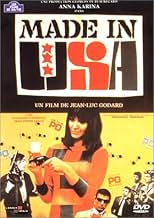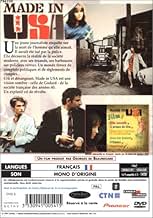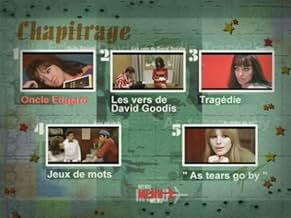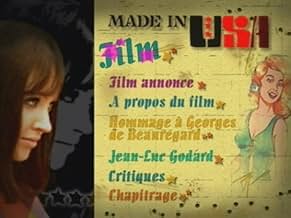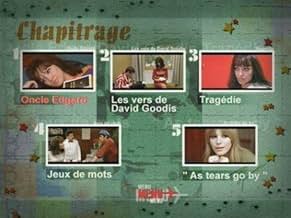Paula, uma escritora de esquerda, vai a Atlantic-Cité para descobrir mais sobre a morte de Richard P., seu amante e antigo colega.Paula, uma escritora de esquerda, vai a Atlantic-Cité para descobrir mais sobre a morte de Richard P., seu amante e antigo colega.Paula, uma escritora de esquerda, vai a Atlantic-Cité para descobrir mais sobre a morte de Richard P., seu amante e antigo colega.
- Direção
- Roteiristas
- Artistas
- Paula Nelson
- (as AK)
- Richard Widmark
- (as LS)
- Donald Siegel
- (as JPL)
- David Goodis
- (as YA)
- Man with Marianne Faithfull
- (não creditado)
- Policeman
- (não creditado)
- Richard Nixon
- (não creditado)
- Inspector Aldrich
- (não creditado)
- Bill Poster
- (não creditado)
- Barman
- (não creditado)
- Workman in bar
- (não creditado)
- Dental Assistant
- (não creditado)
- Richard Politzer
- (narração)
- (não creditado)
- Robert MacNamara
- (não creditado)
- Girl in Bandages
- (não creditado)
- Doris Mizoguchi
- (não creditado)
- Self
- (não creditado)
- Direção
- Roteiristas
- Elenco e equipe completos
- Produção, bilheteria e muito mais no IMDbPro
Avaliações em destaque
** (out of 4)
Jean-Luc Godard's homage to American film noir has a mysterious woman (Anna Karina) trying to figure out who killed her former lover. The woman travels throughout France questioning various men trying to figure out who was behind the murder while the viewer tries to figure out why they're bothering watching the film. There's no question that Godard is a legend of the screen but there's also no question that many, many people hate him. Hate's too strong of a word but I do admit that I think the director likes to be frustrating and the more people he makes mad I'm sure the happier he is. The story itself really isn't all that interesting and I found it funny that Godard had said in interviews that he was influenced by the Humphrey Bogart classic THE BIG SLEEP. The two films have very little in common and I'd say there's also very little homage to the classic noirs of the 40s and 50s. For the most part the film succeeds in being weird but like most Godard movie it's still well-made no matter how silly, boring and stupid it gets. I think what I liked most about the film were the colors that Godard uses on our main character. When we first see her she's wearing a multi-color dress and throughout the movie her wardrobe is clearly the most interesting and entertaining thing on the screen. I liked the way Godard used this colors to really light up the scene just like filmmakers would use shadow and fog to bring to life their noirs. The story itself I found to be very uninteresting and there wasn't a single second where I cared what was going on and I certainly didn't care who killed the former lover. I'm sure some Godard fans would say that was what the director was going for and I'd personally believe this but at the same time I just don't fall into the group who believes you can be pointless and unconventional and make it entertaining. The performances are pretty good for what they are but none of them really jump out at you. The film has fun mentioning earlier films and we even get Bogart's name thrown up and one character is named Richard Widmark. MADE IN U.S.A. is a film that I'm sure has some fans but I found it rather hard to sit through even though it's well-made.
Do not watch this movie late at night or while doing anything that will cause you to glance away from the screen. Every moment in this film is necessary, every word that Godard has our actors speak - while at times confusing and thought provoking - is needed to tell this dis-narrative story. Godard is a master behind the camera for this film - giving us an early glimpse as to what was in store with "Pierrot Le Fou", his bold color and well read characters (each one is always holding a book - Bravo!), are just the crust. What made "Made in USA" stand out was the obvious connections to Walt Disney, the "Big Sleep", and nearly everything coming out of the 60s in America, but what makes Godard impressive, is that one needs to search to see it. He doesn't spoon feed you a narrative that makes your heart gush at the end, Godard creates challenging cinema that will not be enjoyed by all, but if developed - if watched over time - if studied, remains important even 43 years later.
"Made in USA" is another Criterion release that looks and sounds perfectly, but - even with my discussion on how great Godard's work is - isn't the greatest release from the master. Yep, I am a Godard fan, but I am picky. I didn't enjoy "Breathless", but "Pierrot Le Fou" I hold very highly - and this - well, "Made in USA" is intelligent, but perhaps a bit too pretentious. The idea behind this film is solid, but it is the execution that had me nervous. Godard is eloquent in introducing us to certain characters and elements, but gives them names of his favorites like McNamara and Nixon that just feels weighted by symbolism and inside jokes. The viewing took place over the course of three days, not due to the diminishing subject, but because a rewind was needed to ensure that parts didn't go missing or lost. Crafting one part puzzle, one part social commentary, one part comedy is difficult - and for the beginning film watcher - this probably isn't the best film to first experience Godard. Here is what I liked - I loved not knowing. What was exhilarating about this feature was the unknown. The confusing dialogue, the menacing tape voice, the constant barrage of planes flying overhead (if that IS what that noise was), and the possible hope of knowing Richard's last name - keeps one wanting to finish, but getting there is a battle. The dialogue is either a love or hate moment. As there is no linear story, from the spoken perspective, and it is easy to get lost in Godard's cluttered words. For myself, it was at times refreshing - and at other times a disaster. Without a linear narrative, it was difficult to understand how one character fit within the scheme of events. What was happening between Paula and Mr. Typhus? Just thinking about it gives me a headache.
The scenes that stood out in this film were the bartender moments (where you could call him Paul or Bartender, but not "sir"), the pinball machine in the garage, and the billboard store room characters. These made me chuckle and see the humor that Godard was demonstrating, but the others just felt murky and disjointed. Again, I would like to state that every scene was necessary, but were they great? The imagery was spectacular - giving us the color palette that he would later use in "Pierrot Le Fou" - and the cinematography followed suit. For me, it was just the language the bogged me down. I wanted to know these characters further, I wanted to further know the story of the skulled man, and who was double crossing who. "Made in USA" is an important film, I am glad to see it within the Criterion catalogue, but it is an advanced film. The average film watcher will not like this movie, even I felt lost sometimes - but I am so very happy that I watched it.
In another review, this film was quoted as a "B-side" to the Godard cannon, and I couldn't agree more. Could I watch this movie again? Absolutely, but not right away. I look forward to re-exploring this piece of cinema, understanding what I missed, and seeing the inside moments that may have slipped by me the first time. "Made in America" isn't perfect, and I don't know anyone that can take a ten minutes of a tape playing discussing politics, but this self-proclaimed "B-side" finally has a release it deserves.
Grade: *** 1/2 out of *****
Yeah, sure I admit his historical value, the man made a huge change in to the course of film making, and I respect him for that. I have also read Godard's book about the structure and nature of film, and found it very fascinating. Still, for a man who knows a lot about the structure of cinema, a decision to throw every single characteristic in storytelling away, feels very strange to me. It just doesn't work. He, if anybody should know, that they don't exist for nothing.
I can see why he achieved this "film god" status. He was something never seen before, something outrageous. But hey people, let's face it. An hour long political essay disguised as a movie is not "beutifully poetic" or what ever you want to call it. It's just plain boring. No one ever has anything else to say about Godard's movies, than they are "surrealistic" and have such a "strangely poetic mood" in them. Like it's some kind of a magnitude. Poetic or not, The characters are unidimensional and flat.
If you want poetic movies with surrealistic mood, I suggest you to watch for example Robert Bresson's, Andrei Tarkovsky's or Krzysztof Kieslowski's films. They have a lot more in them than just the mood.
Out of 100, I give it 71. That's good for ** out of ****.
Seen at home, in Toronto, on November 26th, 2002.
It seems the real inspiration behind this was the disappearance of a prominent Moroccan leftist leader in Paris, Ben Barka. One can imagine the scandal caused at the time, how much it said about France and the West, especially to someone like Godard who would be attuned to receive it.
The first thing to glean then is that instead of filming the outrage, the obscuring of truth and malaise, using fiction, Godard reverts back to image and cinema, about fiction. To that effect he plucks a potboiler story from a book about a woman who travels to a coastal town where her revolutionary lover has told her to meet him only to find him mysteriously dead, but instead of filming the mystery and noir conspiracy, Godard films a disjointed tapestry of image and citation.
There are many of these, quotes, abrupt cuts and insertions, ruminations on camera, agitprop played from tape-recorders, all first of course Godard's fooling with cinema to see what it is made of, but moreover his oblique way of delivering the obscuring of truth, the disjointed nature of living in a world where people can mysteriously disappear and we can only grasp at fictions. As more of an afterthought he can joke that this knot of indecipherable plot is his version of The Big Sleep.
More fascinating is what all this shows of Godard. There's a bourgeois intellectual in him, that side of him he would run away from after Weekend, who wants to present his view of a concave reality, but none of it deep, transformative or unsettling, always thinly exposing thin artifice. There's of course talk of Disney and Bogart, there's a Rue Preminger, an inspector Aldrich. Tarantino- isms.
But also a spiritual side of him, a burning desire to transcend the clutter of narratives and mind; at one point Anna Karina whispers about how she would rather have nothing instead of everything as a way of reaching the absolute, it's this absolute that likely he chased in the chimera of politics and beyond. He doesn't know yet that this nothingness is not only another thought or another belief but a cessation of thought, a suspension of disbelief. He would later.
It's this other Godard who is a gentle soul, contains the child fascinated by image, the poet fascinated by love, perhaps not the philosopher troubled by being which was only more thought stood in his way. This side is as stifled here, unable to pierce through the cutouts, as it was after Weekend when he wasted his talent in things like Pravda, and was only really let flourish in the 90s, his transcendent period when you must find him again.
Você sabia?
- CuriosidadesThough based on "The Jugger" by Richard Stark (Donald E. Westlake), the author received no compensation for this adaptation. Westlake, who passed away at the end of 2008, successfully kept the film from being shown in the US during his lifetime.
- Citações
Marianne Faithfull: It is the evening of the day / I sit and watch the children play / Smiling faces I can see / But not for me / I sit and watch / As tears go by / My riches can't buy everything / I want to hear the children sing / All I hear is the sound / Of rain falling on the ground / I sit and watch / As tears go by / It is the evening of the day / I sit and watch the children play / Doing things I used to do / They think are new / I sit and watch / As tears go by
- ConexõesEdited into Bande-annonce de 'Made in U.S.A.' (1966)
- Trilhas sonorasAs Tears Go By
Written by Mick Jagger, Keith Richards and Andrew Loog Oldham
Performed by Marianne Faithfull
Principais escolhas
- How long is Made in U.S.A?Fornecido pela Alexa
Detalhes
Bilheteria
- Orçamento
- US$ 50.000 (estimativa)
- Faturamento bruto nos EUA e Canadá
- US$ 95.209
- Fim de semana de estreia nos EUA e Canadá
- US$ 11.147
- 11 de jan. de 2009
- Faturamento bruto mundial
- US$ 95.304
- Tempo de duração1 hora 30 minutos
- Mixagem de som
- Proporção
- 2.35 : 1
Contribua para esta página





